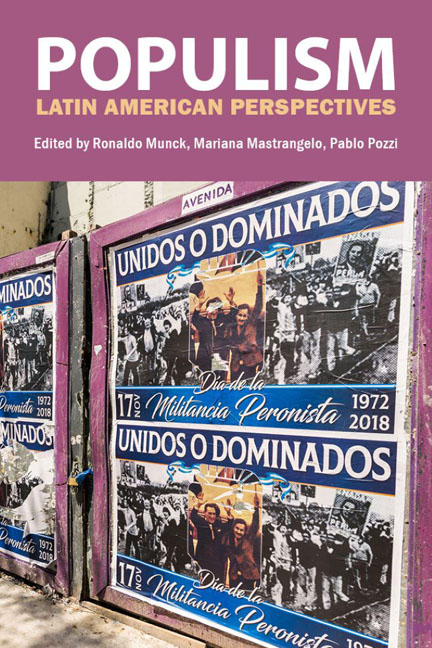Book contents
- Frontmatter
- Contents
- Abbreviations and acronyms
- Foreword
- Introduction
- 1 Populism in Latin America: development, democracy and social transformation
- 2 Peronism in Argentina: left or right?
- 3 The populist left in Chile: socialists and communists from 1936 to 1973
- 4 The left and the Workers’ Party in Brazil: a party between populism, social policies and the popular vote
- 5 Brazil, Bolsonaro and populism of the right
- 6 Political dilemmas of the government of López Obrador: between populism, democracy and the left in Mexico
- 7 The Bolivarian process in Venezuela: socialism, populism or neoliberalism?
- 8 Populist responses to crises of market democracy: the case of Bolivia’s Evo Morales
- 9 Ecuador: populism and the 2007– 17 political cycle
- 10 The Nicaraguan crisis and the mirage of left populism
- 11 Populism and the right in Latin America
- 12 Populism and the left in Latin America
- Afterword: a tale of two “people”: national popular and twenty-first-century Latin American populisms
- Contributors
- Index
3 - The populist left in Chile: socialists and communists from 1936 to 1973
Published online by Cambridge University Press: 23 January 2024
- Frontmatter
- Contents
- Abbreviations and acronyms
- Foreword
- Introduction
- 1 Populism in Latin America: development, democracy and social transformation
- 2 Peronism in Argentina: left or right?
- 3 The populist left in Chile: socialists and communists from 1936 to 1973
- 4 The left and the Workers’ Party in Brazil: a party between populism, social policies and the popular vote
- 5 Brazil, Bolsonaro and populism of the right
- 6 Political dilemmas of the government of López Obrador: between populism, democracy and the left in Mexico
- 7 The Bolivarian process in Venezuela: socialism, populism or neoliberalism?
- 8 Populist responses to crises of market democracy: the case of Bolivia’s Evo Morales
- 9 Ecuador: populism and the 2007– 17 political cycle
- 10 The Nicaraguan crisis and the mirage of left populism
- 11 Populism and the right in Latin America
- 12 Populism and the left in Latin America
- Afterword: a tale of two “people”: national popular and twenty-first-century Latin American populisms
- Contributors
- Index
Summary
INTRODUCTION
There is only one great consensus about populism, and that is that it is a phenomenon that is difficult to define. Indeed, although Latin America has had different populist experiences since the beginning of the twentieth century, it is no less true that its conceptualization continues to be complex. At the beginning of the 1970s, Octavio Ianni, one of the intellectuals who most deeply explored this issue, argued that, despite the dissimilar historical experiences lived by the countries of the region, populism burst into most of them as a mass movement that was installed in the centre of the structural ruptures that accompanied the crises of the world capitalist system and, by extension, of the Latin American oligarchies (Ianni 1973: 85). From these crises and with the masses constituted as political actors, the state was restructured under bourgeois leadership. The new ruling elites, supported by different social sectors, especially workers and the middle classes, carried out a profound reorganization of the economy, emphasizing state dirigisme, and based on it, redistributed part of the income expressed as social policy. This, in turn, operated as a strategy of clientelism which, on the one hand, consolidated the adhesion of the masses to charismatic leaderships and, on the other, reconfigured power relations (Ianni 1973: 106– 49). The regime of passions and emotions played a fundamental role in this, which in the perspective of Rosanvallon, activated the populist mobilization and rooted the bond of relationship with the leader (Rosanvallon 2020: 53– 5).
However, the historical rhythms of this process, as Osmar González (2007: 87– 92) points out, were different. In some countries, such as Peru under Guillermo Billinghurst (1912– 14) or Uruguay during the second period of José Batlle y Ordóñez (1911– 15), the process began at the beginning of the twentieth century. In others, such as Brazil under Getúlio Vargas (1930– 45) or Mexico under Lázaro Cárdenas (1934– 40), the process began in the 1930s.
But populism is not reduced only to the type of state, or to the power relations that were constituted at a given historical moment, nor is it restricted to the leader who embodied it. It also refers to the people, meaning the masses that give political force to the movement. According to this perspective, populist movements were heterogeneous.
- Type
- Chapter
- Information
- PopulismLatin American Perspectives, pp. 49 - 68Publisher: Agenda PublishingPrint publication year: 2023

